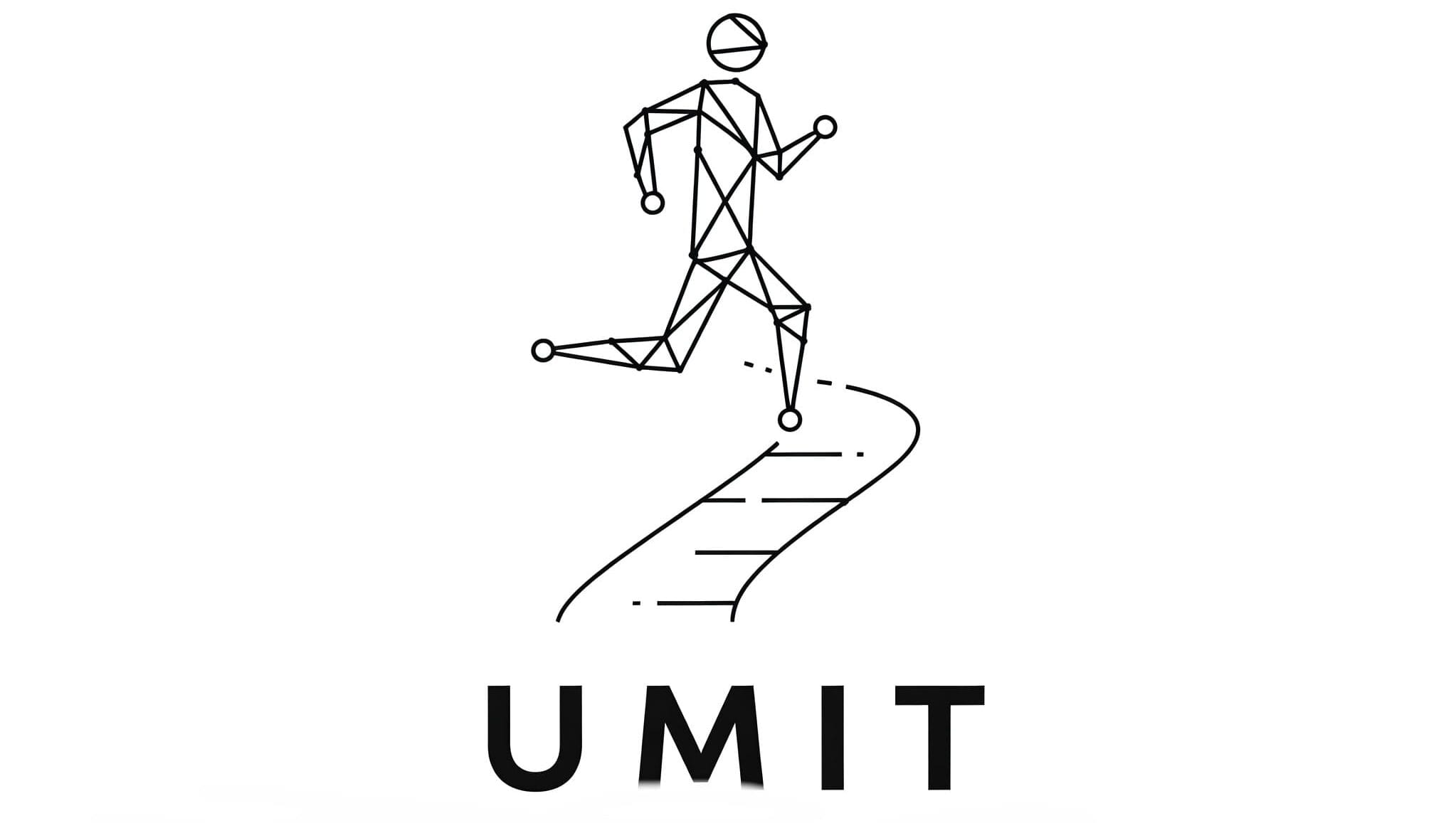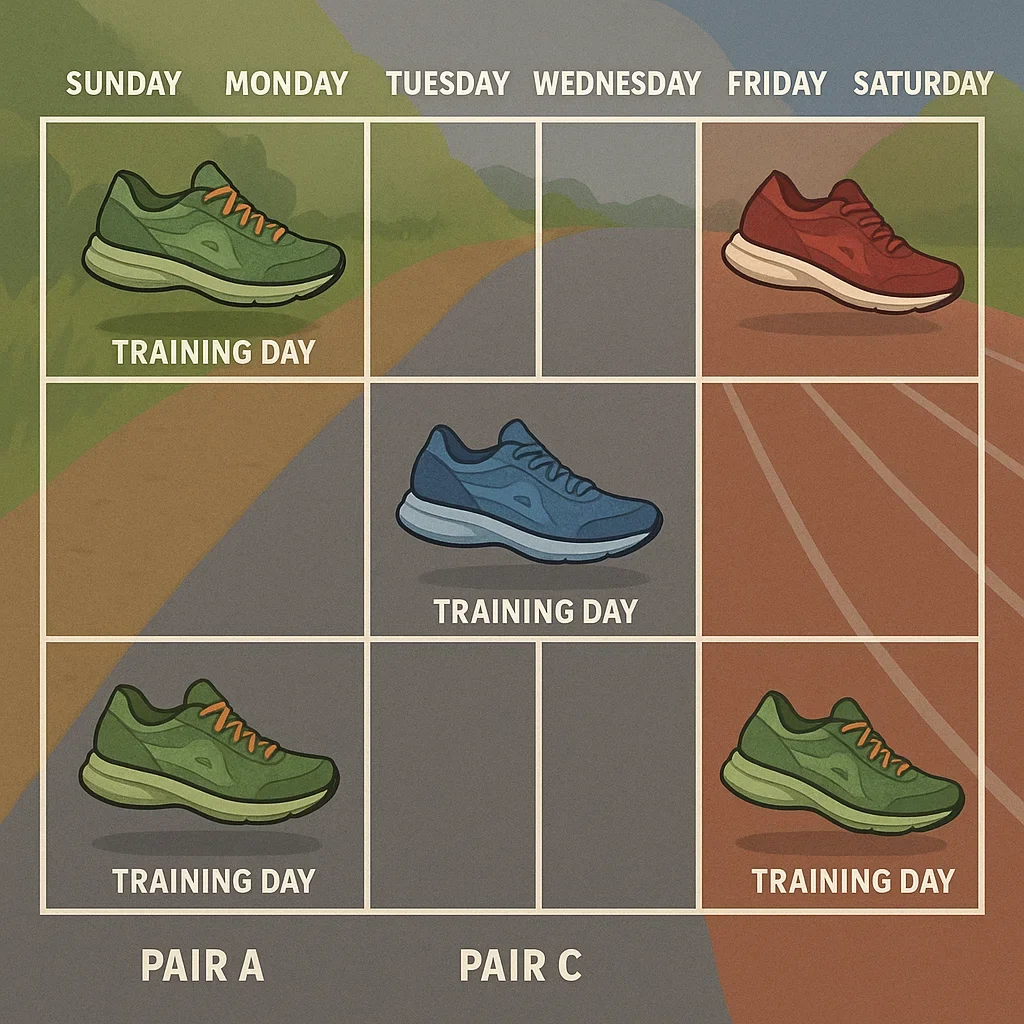🏁 Introduction: Your Shoes Need Rest, Too
You wouldn’t train your legs every day without rest, right?
So why do we expect our running shoes to recover instantly?
Most runners own just one pair and wear them every day until they fall apart. But recent research — and seasoned experience — suggests a smarter strategy: shoe rotation.
The idea is simple: By alternating between two or more pairs of shoes, you not only reduce injury risk, but also extend the life of each midsole foam. And in the long run, this could save your legs and your wallet.
🔄 What Is Running Shoe Rotation?
Shoe rotation means using multiple pairs of running shoes across your weekly training cycle. These can differ by:
- Model – Daily trainer, tempo shoe, recovery model
- Foam type – EVA vs TPU vs PEBA
- Drop, weight, structure – To vary loading and biomechanics
Example: Saucony Triumph for long runs, HOKA Rincon for easy days, Vaporfly for speedwork.
The rotation isn’t random — it’s a planned distribution of stress across different shoe types and foam properties.
🧠 Why Rotation Helps: Midsole Physics 101
When you run, the midsole compresses — sometimes over 3× your body weight. Good foams rebound. But they don’t rebound instantly.
Studies show that foam needs 24–48 hours to return to full volume and energy return after a hard run. If you run again too soon in the same shoe:
- Foam stays compressed
- Cushioning feels flat
- Structural breakdown accelerates
🧪 Think of foam like a muscle — it recovers best with rest.
🔬 What Happens to Foam After Every Run?
Midsole foams — whether EVA, TPU, or PEBA — work by compressing under load and then rebounding. This “energy return” process isn’t infinite.
After each run:
- Foam compresses microscopically with every step.
- Cells deform, expelling air and rebounding slowly.
- If not given time to recover, permanent deformation (aka compression set) begins.
📉 Repeated loading without recovery causes:
- Flattened feel
- Loss of energy return
- Altered biomechanics
- Early breakdown
🧠 This degradation is invisible at first — but your legs will feel it.
⏱️ Foam Recovery Timeline (Average Estimates)
| Foam Type | Recovery Time | Notes |
|---|---|---|
| EVA | 24–36 hrs | Softest, most prone to packing out |
| TPU | 12–24 hrs | Quickest rebound, high resilience |
| PEBA | 24–48 hrs | Soft but slow to recover unless plated |
🔁 Rotating allows each pair to fully recover before the next run — preserving bounce, softness, and structure.
🧪 Lab Findings & Real-World Data
- A 2015 biomechanics study showed repeated runs in EVA shoes reduced impact absorption by 10–25% over 3 consecutive days.
- TPU shoes maintained consistent force dissipation across the same cycle.
- Another test showed that PEBA-based foams without plates lost 15% of their energy return after just 200 miles — mostly due to fatigue, not damage.
📚 Source: Journal of Footwear Science, 2015 & 2018 editions.
🚫 What Happens Without Rotation?
- Shoes feel flat faster
- More muscle fatigue (due to lost rebound)
- Risk of injury increases as form compensates
- Midsole lifespan decreases by up to 25–40%
👟 How Many Shoes Do You Really Need?
You don’t need a closet full of shoes to benefit from rotation.
Even just two pairs — used strategically — can dramatically reduce foam fatigue and joint stress.
| Weekly Mileage | Recommended Rotation |
|---|---|
| < 30 km | 1–2 shoes (alternate every other day) |
| 30–60 km | 2–3 shoes (based on session type) |
| 60+ km | 3+ shoes (recovery, tempo, long run specific) |
📍 Rule of thumb: One shoe per running “purpose” (e.g. long, easy, fast)
🧰 Components of an Ideal Shoe Rotation
1. Daily Trainer
- Durable, balanced cushion
- EVA or TPU foam
- Example: Brooks Ghost, Triumph 22, Pegasus 41
2. Tempo/Speed Shoe
- Lightweight, responsive
- Often PEBA-based
- Example: Saucony Endorphin Speed, HOKA Mach X
3. Long Run Shoe
- Maximum comfort, high stack
- Prefer TPU or blended foams
- Example: Ultraboost Light, ASICS Nimbus, Bondi 8
4. Race Day Shoe (Optional)
- Super shoe with plate + PEBA foam
- Reserved for races/quality sessions
- Example: Nike Vaporfly, Adios Pro 3, Alphafly
💡 Budget Tips
- Buy last year’s model on discount
- Track mileage to rotate based on usage, not just days
- Replace only one shoe at a time, not the whole rotation
- Use Strava or Stryd to assign shoes to each run
📦 Example Rotation (Mid-Level Runner)
- Monday – Recovery Jog: HOKA Bondi 8
- Wednesday – Tempo Intervals: Saucony Endorphin Speed
- Friday – Easy Run: Brooks Glycerin 21
- Sunday – Long Run: Triumph 22
→ Each shoe gets 3–6 days to recover = maximum lifespan + comfort
🩹 Reduced Injury Risk: The Real Power of Shoe Rotation
Beyond midsole preservation, rotation’s biggest benefit may be your long-term health.
Each shoe you wear loads your body slightly differently — changing angles, force absorption, and muscle activation.
Rotating shoes distributes this stress and helps your body adapt more broadly.
✅ Scientific Findings:
- A 2013 study in the Scandinavian Journal of Medicine & Science in Sports found that runners who rotated between shoes had 39% lower injury risk than those who wore a single pair.
- The variety in midsole geometry and foam density appeared to reduce repetitive strain on specific joints and tissues.
🧠 Changing shoes = changing loading patterns = reduced overuse.
🧠 Biomechanical Variety Matters
Wearing the same shoe every day reinforces the same micro-stress patterns.
When you rotate shoes:
- You activate different stabilizer muscles
- You vary joint angles
- You reduce cumulative impact on any one structure
This helps prevent:
- Shin splints
- Plantar fasciitis
- IT band syndrome
- Patellofemoral pain
🏃 Performance Gains Over Time
Consistent foam rebound = more efficient running form.
Fresh shoes = less fatigue = better workouts.
Runners who rotate report:
- Less soreness after hard efforts
- Better bounce in long runs
- Fewer “dead leg” days
- Longer life out of each shoe model
🧘 Mental Freshness Boost
Swapping shoes can give psychological benefit too:
- Feeling of novelty or reward
- Ritual cue for speed days or long runs
- Motivation to stay consistent
🎽 New day, new shoes — new mindset.
📊 Quick Comparison: Rotating vs. Single-Shoe Use
| Factor | Single Pair | Rotation (2–3 Pairs) |
|---|---|---|
| Foam Recovery Time | Insufficient | Optimized (24–48h rest) |
| Cushioning Longevity | 300–500 mi avg | 500–800 mi per shoe |
| Injury Risk | Higher (repetition) | Lower (stress variation) |
| Cost per Month | Moderate upfront | Lower long-term (per mile) |
| Performance Consistency | Declines over time | Remains high longer |
🧠 Rotation = smarter wear management, longer life per pair.
✅ Rotation Decision Guide
Ask yourself:
- 🏃♂️ Do I run more than 3× per week?
- 👟 Does my shoe feel flat before 400 miles?
- ⌛ Do I take 1+ rest days between runs?
- ⚠️ Have I dealt with repetitive injuries?
If you said yes to 2+ → You’ll likely benefit from rotation.
🧰 Best Rotation Strategy by Runner Type
| Runner Type | Suggested Rotation |
|---|---|
| Beginner (<30 km/wk) | 1 daily trainer + 1 recovery/tempo shoe |
| Intermediate (30–60 km/wk) | 1 daily trainer + 1 long run + 1 speed shoe |
| Advanced (60+ km/wk) | 3–4 shoes (match run type + foam variety) |
👣 You don’t need 5 shoes — just 2 smart pairs can change the game.
🏁 Final Verdict: Is Shoe Rotation Worth It?
Absolutely — especially if:
- You want your shoes to last longer
- You’re focused on injury prevention
- You run 3+ times a week and value performance consistency
Rotating shoes is one of the simplest ways to extend foam life, reduce repetitive strain, and get more bounce per mile — without any complex training tweaks.
🔁 Protect your shoes, protect your legs, protect your run.
❓ Frequently Asked Questions
🔁 What is running shoe rotation?
👟 How many pairs should I rotate?
⏱️ How long does midsole foam need to recover?
📉 What happens if I wear the same shoes every day?
🧪 Is there scientific proof that rotation helps?
⚖️ Does my body weight affect foam fatigue?
🧠 Is rotation only about foam recovery?
💥 Will rotating shoes improve performance?
💰 Isn’t rotating shoes more expensive?
📦 Which types of shoes should I rotate?
🧰 What if I only have one shoe?
🔧 How do I track shoe mileage?
🌧️ Should I rotate for weather too?
🧼 Can rotating shoes help them smell less?
🏃 Should I rotate shoes if I run only twice a week?
📏 Do all foams benefit equally from rotation?
📚 Can I mix brands or models in my rotation?
🧠 Is it mentally helpful to rotate shoes?
📉 Will my shoes last longer if I rotate?
📅 Should I schedule rotation days in advance?
🔗 Further Reading
- 🧪 The Influence of Running Shoe Type on Injury Risk – PubMed
- 📉 Effects of Footwear Rotations in Injury Prevention – SAGE Open Medicine
- 🧠 Why Rotating Shoes Keeps Your Body (and Brain) Fresher – Runner’s World
- ⚙️ How to Track Shoe Mileage in Garmin – Garmin Blog
- 👨🔬 Cushioning Performance Over Time in Running Shoes – NCBI
🧠 Quiz: Test Your Shoe Rotation Knowledge
- What is the main purpose of shoe rotation?
- How long does EVA foam typically need to recover between runs?
- True or False: Rotating shoes reduces injury risk.
- Which foam type recovers fastest after compression?
- How does shoe rotation affect performance?
- What is “compression set” in running shoes?
- Name one benefit of using different shoes for different runs.
- True or False: All foams benefit equally from rotation.
✅ Quiz Answers
- To allow midsole foams to recover and reduce repetitive stress on the body.
- 24–36 hours
- True
- TPU
- It maintains cushioning feel, reduces fatigue, and protects form.
- Permanent deformation of foam after repeated loading
- Biomechanical variety; engages different muscles and reduces overuse
- False
🏁 Final Thoughts
Running shoes are an investment — not just in gear, but in your training, your recovery, and your health. And like any smart investment, they need a strategy.
Rotating your shoes isn’t just about comfort or saving foam. It’s about honoring the workload your body endures with every mile. It’s about reducing stress where it matters, and giving your gear time to breathe.
Whether you’re running three times a week or training for your next ultramarathon, a thoughtful rotation can help you run stronger, longer, and safer — without burning through shoes (or knees).
So if you’ve been relying on a single pair to carry the load, maybe it’s time to bring in some reinforcements.
Your shoes — and your legs — will thank you.
🎥 Video Block: Shoe Rotation & Midsole Wear
Running Shoe Rotation – An ESSENTIAL for every Runner
Explores the importance of rotating running shoes to prevent midsole wear and enhance performance.
Everything You Need To Know About Shoe Rotations
Provides comprehensive insights into the benefits and methods of rotating running shoes.
How To Find Your Perfect Running Shoe Rotation
Guides viewers on selecting the ideal combination of running shoes for rotation based on individual needs.

About the Author
Lost Pace is an ultramarathon runner, shoe-tester and the founder of umit.net. Based year-round in Türkiye’s rugged Kaçkar Mountains, he has logged 10,000 + km of technical trail running and completed multiple 50 K–100 K ultras.
Blending mountain grit with data, Lost analyses power (CP 300 W), HRV and nutrition to craft evidence-backed training plans. He has co-written 260 + long-form guides on footwear science, recovery and endurance nutrition, and is a regular beta-tester of AI-driven coaching tools.
When he isn’t chasing PRs or testing midsoles, you’ll find him sharing peer-reviewed research in plain English to help runners train smarter, stay healthier and finish stronger.
Ultrarunner · Data geek · Vegan athlete

